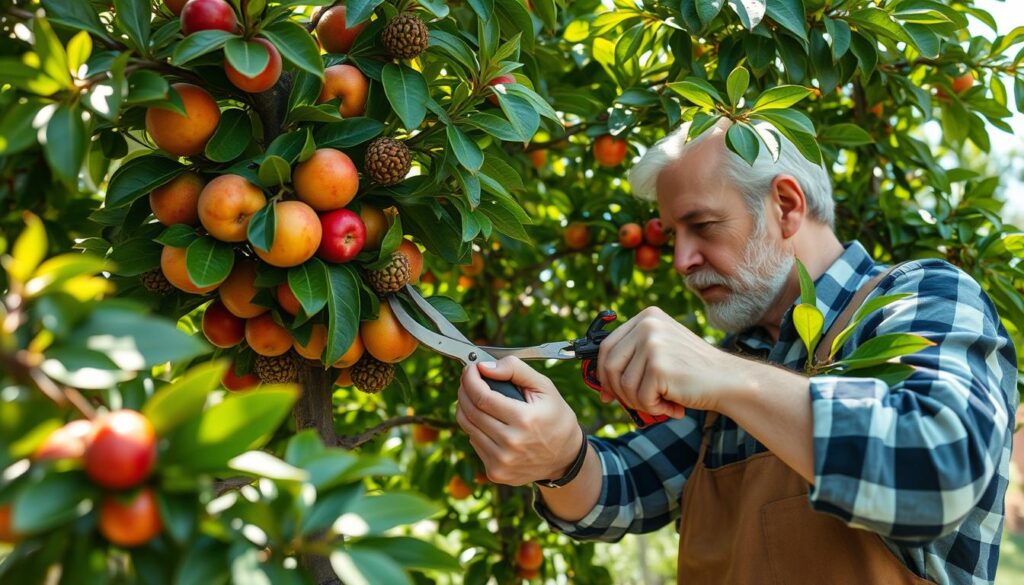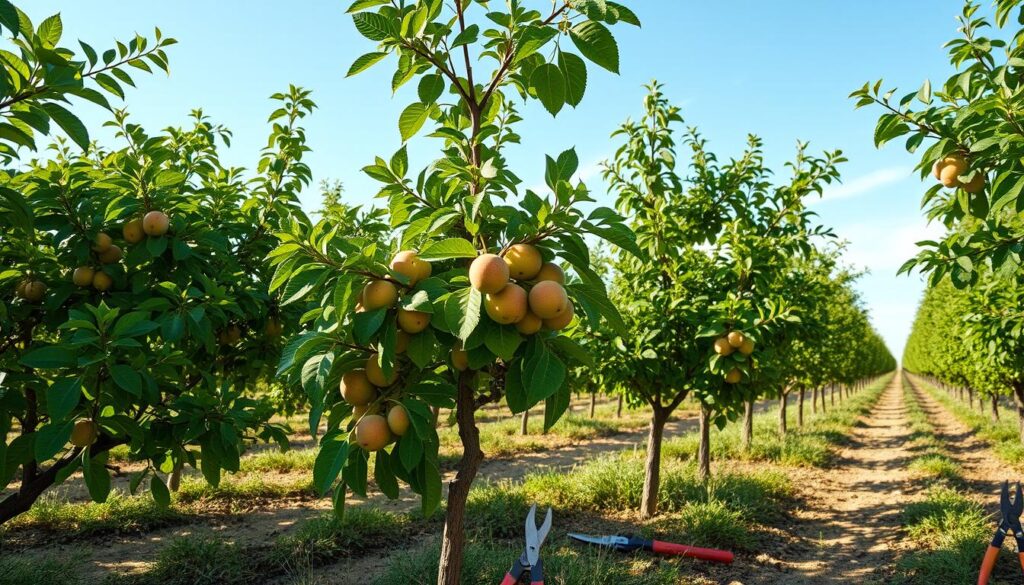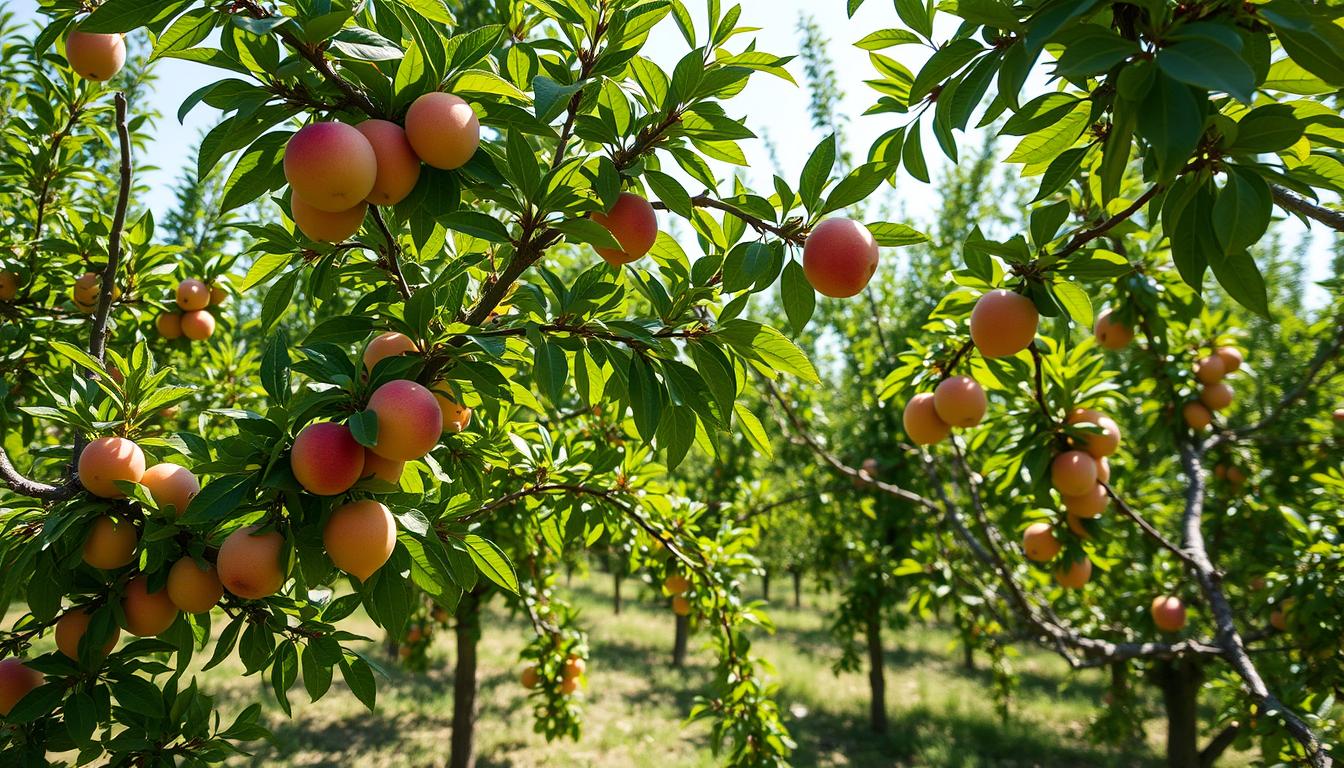Maximizing fruit production starts with knowing how to prune fruit trees for maximum yield. Pruning is key for tree health and fruit quality. It makes harvesting easier and boosts yield. Learning pruning techniques helps my fruit trees grow well and give plenty of fruit.
Key Takeaways
- Pruning apple trees in late winter/early spring is ideal when they are dormant.
- Removing unnecessary branches enhances fruit size and flavor while promoting resistance to pests and diseases.
- Thinning branches allows for better light penetration and aids in tree drying during wet conditions.
- Up to 2 to 3 feet of growth may be safely removed from apple trees to improve air circulation.
- Fertilizing after pruning can significantly benefit tree health and fruit production.
- Young trees require pruning to establish a strong structure for future fruiting.
- Over-pruning can lead to sunburn on branches, which is detrimental to tree health.
Introduction to Fruit Tree Pruning
Fruit tree pruning is key for keeping trees healthy in any orchard. By following a good pruning guide, trees grow strong and stay productive. Pruning shapes trees, prevents disease, and boosts fruit quality.
Pruning offers many benefits, like better air flow and more light. It also encourages new growth. I’ve found that crotch angles between 45 to 60 degrees are best. This helps limbs support the tree, especially when it’s loaded with fruit.
Training young trees makes future care easier. Pruning controls tree size, making it simpler to spray and manage. Dwarfing rootstocks benefit from careful pruning to keep them stable.
It’s important to balance the tree’s top with its roots, especially early on. Prune fruit and nut trees soon after planting. This helps roots grow strong, leading to healthier trees.
Pruning is an art that requires strategy. Thinning limbs supports heavy fruit, while heading back promotes lateral growth. A well-pruned tree yields more and better fruit.
Learning about tree training and pruning is crucial for gardeners and growers. The next sections will explain why pruning is vital for fruit trees. They’ll show how it leads to a fruitful harvest.
Why Pruning is Essential for Fruit Trees
Pruning is key to keeping fruit trees healthy and strong. Using expert pruning techniques boosts tree health and harvest quality. A well-pruned tree gets better air and light, helping it grow strong fruit.
Benefits of Pruning for Tree Health
Pruning is crucial for fruit trees. It removes dead, sick, and broken branches. This helps the tree grow better and support more fruit in the future.
Regular pruning also keeps the tree’s structure sound. It prevents branches from breaking off, keeping the tree stable.
Impact on Fruit Quality and Quantity
Pruning affects how well and how much fruit a tree produces. It balances the growth of new and old wood. This improves the tree’s fruiting ability.
More light and air from pruning also make leaves healthier. This leads to better fruit ripening. Pruning also helps control pests and diseases by removing infected parts. This way, pruning increases the tree’s fruit yield, leading to a bigger harvest.

Understanding Tree Growth and Structure
Knowing how trees grow and are structured is key for good fruit tree pruning. Learning basic pruning terms helps me use the right tree care methods. Terms like branch collar, scaffold limb, and spur guide my pruning choices.
Basic Terminology in Pruning
Learning pruning terms is very helpful. Some important ones are:
- Branch Collar: The swollen area where the branch meets the trunk, crucial for the tree’s healing.
- Scaffold Limb: The main horizontal branches that support smaller branches.
- Spur: A short branch that bears flowers and fruits, essential for maximizing yield.
Tree Structures: Central Leader vs. Open Center
There are two main tree structures: central leader and open center. Each affects how I prune and how the tree grows.
| Tree Structure | Description | Best For |
|---|---|---|
| Central Leader | Features a dominant central stem with well-distributed scaffold branches. | Apple, apricot, cherry, pear, and plum trees. |
| Open Center | Emphasizes an empty center to allow light penetration and air circulation. | Peach and nectarine trees. |
Understanding these structures helps me prune strategically. This improves light and air in the tree, leading to better fruit quality and yield. Knowing tree structure is crucial for good tree care, supporting healthy growth and fruit production.
Timing Your Pruning Correctly
Knowing when to prune fruit trees is key to their health and fruit production. The right time to prune can affect how well they grow and how much fruit they produce. Pruning at the best time helps the trees grow strong and healthy next season.
Best Seasons for Pruning Fruit Trees
The best time to prune most fruit trees is late winter to early spring. This is when the trees are asleep, or dormant. Pruning then helps them heal faster and grow stronger when they wake up.
For stone fruit trees, prune from just before they bloom to two weeks after the petals fall. This helps avoid diseases like brown rot. Using these tips for pruning fruit trees right can help your trees grow better and produce more fruit.

Effects of Seasonal Changes on Pruning
Seasonal changes affect how well a tree can grow. Pruning in late winter is best because it doesn’t hurt the tree’s hardiness. Trees can recover from winter pruning in just two weeks, getting back to full strength.
Summer pruning, especially if it’s too much, can weaken a tree. It’s important to balance cutting back too much and encouraging growth. This keeps your fruit trees healthy all year.
For more gardening tips and advice, check out this great resource.
How to Prune Fruit Trees for Maximum Yield
Pruning fruit trees is key to getting the most fruit and keeping them healthy. By following the right steps, I can make the fruit better and the tree stronger. This guide will show you how to prune fruit trees effectively.
Step-by-Step Guide to Effective Pruning
The best time to prune fruit trees is when they’re dormant, usually in December, January, or early February. For Apricots, prune in the summer. Start by cutting off any dead or sick branches and unwanted shoots.
Then, thin out branches that grow up or down. This lets more light and air into the tree. Use thinning cuts to remove branches and heading cuts to shorten them. This helps the tree grow better.
After setting the main structure, prune the outer growth. This keeps the tree balanced and helps it produce more fruit. Regular pruning also leads to bigger and better fruits over time.
Common Mistakes to Avoid
Many people make mistakes while pruning that can hurt fruit production. One mistake is cutting too much foliage, which stresses the tree. Prune in the spring only if necessary, as it can harm the tree.
It’s also important to know which wood produces fruit. Some trees need old wood, while others need new wood. This knowledge helps with pruning.
Watch out for water sprouts, which use too much energy and slow growth. Remove them to keep the tree healthy. Remember, less pruning is better. Aim to keep the tree’s structure without harming it.
For a more detailed approach, consider getting help from experts like Green Vista. Using these best practices for pruning fruit trees will keep your trees healthy and fruitful.
Choosing the Right Tools for Pruning
Choosing the right tools is key for effective pruning. I make sure I have the right tools to make pruning easier and more efficient. This leads to healthier fruit trees.
The right tools help make better cuts. This promotes better tree health and fruit production.
Essential Pruning Tools You Need
Every gardener needs certain pruning tools. Here’s a quick look at some must-haves:
- Bypass Pruners – Ideal for making clean cuts on small branches and stems.
- Loppers – Great for reaching and cutting larger branches, especially those too thick for pruners.
- Folding Pocket Saws – Convenient for on-the-go pruning tasks and can cut through thicker branches.
- Silky Saws – Known for their sharpness and precision, perfect for more delicate cuts.
- Pole Saws – Helps reach high branches without the need for ladders.
- Chainsaws – Useful for removing large limbs on mature trees.
- Ladders – Essential for safely reaching elevated branches.
Choosing the right tool depends on the branch thickness. Using the right tool makes pruning easier and leads to better results. For more detailed tool recommendations, check out this guide.
Maintenance Tips for Your Pruning Tools
Maintaining pruning tools is just as important as having the right tools. Well-maintained tools provide cleaner cuts, which help prevent disease in fruit trees. Here are some effective maintenance strategies:
- Sharpening Blades – Regularly sharpen the blades of pruners and saws to ensure smooth cuts.
- Cleaning Tools – Wipe down tools after each use to remove sap and debris, which can cause rust.
- Oiling Moving Parts – Apply oil to joints and hinges to keep them operating smoothly.
- Storing Properly – Store tools in a dry place to prevent corrosion, hanging tools when possible to avoid damage.
By focusing on maintaining pruning tools, I can ensure they perform optimally season after season. This attention to detail leads to healthier trees and ultimately a better harvest. For even more specifics on tool maintenance, visit this informative article.
Implementing Best Practices for Pruning
Pruning is crucial for fruit trees’ health and productivity. It’s important to know the difference between thinning and heading cuts. These methods affect how much light and air trees get.
Choosing the right pruning technique is key. It impacts tree growth, health, and fruit yield.
Thinning vs. Heading Cuts
Thinning cuts remove branches for better light and air. This helps fruit grow well. Trees grow stronger and faster with this method.
Heading cuts shorten branches, leading to denser growth. This can block light and air. Knowing when to use each is essential for tree health.
Understanding the Importance of Light and Airflow
Good light and air in trees boost photosynthesis and pest control. I suggest a tall, narrow canopy for even light. This encourages strong growth and manages fruit well.
Regular pruning in the dormant season improves air and light. It ensures all branches get enough light for growth.
Pruning Specific Types of Fruit Trees
Knowing what each fruit tree needs is key to good care. Apple and pear trees do best with the central leader pruning method. This shape helps with light and supports the fruit’s weight.
It focuses on horizontal growth. This means more fruit and better quality.
Apple and Pear Trees
Pruning apple and stone fruit trees is vital for their health and fruit. Prune in late winter or early spring, just before new growth starts. This is when the tree is dormant.
Pruning at this time helps shape the tree without harming its growth. It also lets more light and air in, making the fruit bigger and sweeter.
Stone Fruit Trees: Peaches and Plums
Stone fruit trees like peaches and plums need an open vase pruning style. This style lets in lots of light and air. It’s important for growing great fruit.
For peach trees, prune about 50% of last year’s growth. This encourages new growth for the next season. Each pruning method boosts the tree’s health and fruit production. For more on pruning, visit my affiliate programs.



Leave a Reply